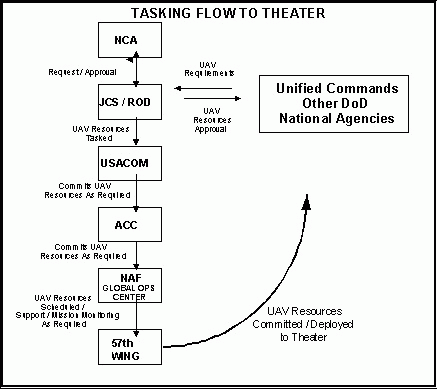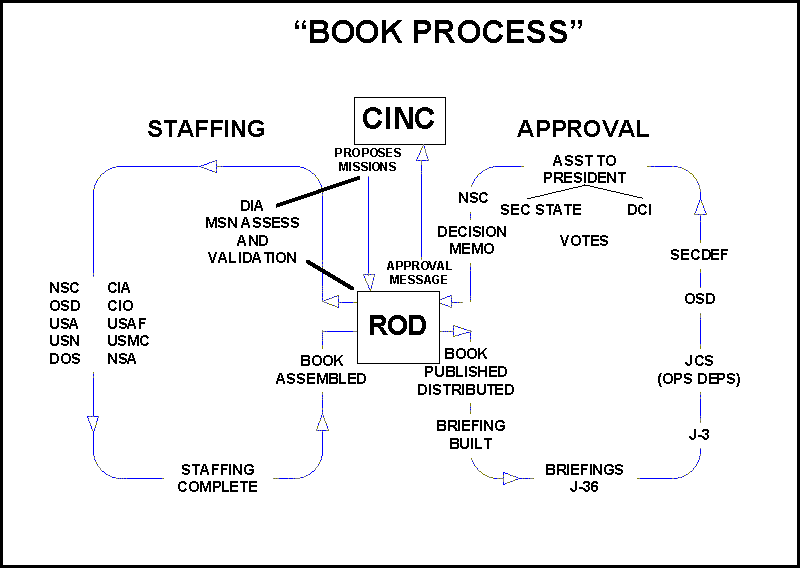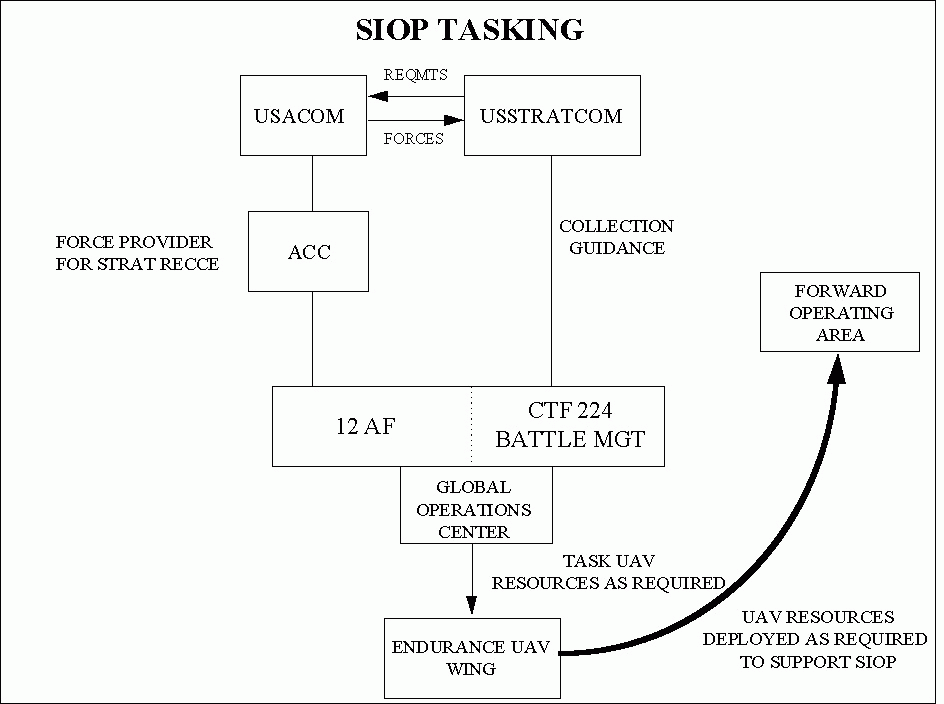
[Back]

[Index]

[Next]
 [Back] |
 [Index] |
 [Next] |
SECTION 4 - COMMAND AND CONTROL RELATIONSHIP STRUCTURE
4.1 COMMAND AND CONTROL OF AIR FORCE ENDURANCE UAVs USACOM will exercise combatant command (COCOM) of all Department of Defense operational endurance UAV assets. Currently, these vehicles include the Predator, Global Hawk, and DarkStar UAVs. Operational control (OPCON) of endurance UAVs will be the responsibility of ACC, USACOM�s Air Force component. ACC will assign Predator to the Air Warfare Center�s, 57 WG, 11 RS. OPCON of deployed endurance UAVs transfers to the theater CINC, once the asset is in the supported area of responsibility (AOR).
4.2 PEACETIME OPERATIONS During peacetime, Predator endurance UAVs will be based in the continental United States (CONUS) under COCOM of USACOM with ACC providing OPCON.
4.2.1 Training and Exercise For peacetime exercises and training, supported CINCs may request endurance UAVs through the JCS/Reconnaissance Operations Division (ROD). The ROD allocates forces for training and exercises. Based on ROD�s allocation, USACOM tasks ACC to support the requesting theater CINC�s exercise and training needs.
4.2.2 Peacetime Deployment During peacetime deployment, UAVs and associated ground stations supporting exercises will fall under the supported CINC�s exercise command structure for exercise tasking.
4.2.3 Sensitive Reconnaissance Operations (SRO) When deployed to support real-world reconnaissance operations, short of crisis or war, the endurance UAVs will "chop" to the theater CINC or his designated representative for OPCON over SRO. (SRO is defined as "Non-wartime reconnaissance operations by manually or remotely operated DoD platforms involving significant military risk or political sensitivity. The level of sensitivity is determined by analyzing the collection objectives, means of collection, and area of operations.")
4.2.3.1 Peacetime Tasking Process During peacetime, endurance UAV collection efforts are primarily directed towards satisfying theater CINC and NCA requirements under SRO. Inputs from the warfighting Commands are combined, on a monthly basis, with other government agency requirements, by the JCS/Reconnaissance Operations Division (ROD) (see Figure 4-1). These requirements are then sent to the Defense Intelligence Agency (DIA) and the National Security Agency (NSA) for validation. Validated monthly requirements are forwarded to the National Security Council (NSC) for approval (see "Book Process" Figure 4-2). Upon approval, ROD then notifies the theater CINCs of the approved SRO schedule. USACOM (thru ACC) provides forces to theater CINCs, who in turn, execute each mission based on local conditions.
4.2.3.2 "Book Process" As with all SRO operations, the tasking approval authority remains embedded within the JCS Reconnaissance Schedule Approval/Execution Process ("Book Process").

Figure 4-1: Predator Endurance UAV Peacetime Tasking Flow

Figure 4-2: JCS Reconnaissance Schedule Approval / Execution Process "Book Process"
4.3 CRISIS OR WARTIME OPERATIONS During contingency operations or support of wartime operations, the UAV becomes a theater asset dedicated to the appropriate Unified CINC or JFC. Collection requirements for UAV operations will be reviewed, validated, and prioritized by the J-2. The J-3, in coordination with the J-2, will forward these requirements to the commander exercising TACON over these theater reconnaissance and surveillance assets, as depicted below in Figure 4-3. The component commander will then task the asset to satisfy the JFC requirement. Normally, airborne reconnaissance and surveillance assets will be tasked by the JFACC in the air tasking order (ATO) in accordance with JFC priorities.

Figure 4-3: Endurance UAV Wartime Tasking Procedures
4.4 Single Integrated Operational Plan As directed by National Command Authority, USACOM will provide endurance UAVs as required to support USSTRATCOM taskings. Once endurance UAVs are allocated for use by USSTRATCOM, they become dedicated force enhancement assets managed by Commander Task Force 224 (CTF 224) Battle Management.

Figure 4-4: Endurance UAV Single Integrated Operational Plan Tasking Procedures
4.5 JOINT FORCE COMMANDER�S (JFC) GUIDANCE The JFC guidance provides unity of effort between subordinate component commanders. Like all theater reconnaissance assets, UAVs will be tasked to support the overall JFC strategy and guidance. The JFC can be a CINC, subunified commander, or JTF commander.
4.5.1 UAV Support If UAV support is required, the requesting commander will provide required coverage area, effective employment times, and sensor priorities to his component commander. The component commander will forward this request to the JFC J-2 for prioritization. The JFACC will determine the number of vehicles needed to provide the requested coverage and will consider this in his daily submission of the apportionment recommendation. The JFC, through his daily apportionment decision will determine which commanders will receive UAV support. During mission execution, the supported unit may request changes in the coverage area, times, or radar priorities by coordinating through the appropriate command and control authorities.
4.6 JOINT FORCE AIR COMPONENT COMMANDER RESPONSIBILITIES
4.6.1 In order to provide centralized control of air operations, the CINC will normally identify a JFACC. The JFACC must establish a process for integrating the UAVs in the overall Airspace Control Plan (ACP) developed by the Area Air Defense Commander (AADC) and the Airspace Control Authority (ACA). The ACP will have detailed procedures for UAV operations that will deconflict manned and unmanned operations in joint use airspace; these procedures should cover both pre-planned UAV missions as well as allow for contingency flight path/mission deviations. Specific procedures will be contained in the special instruction (SPIN) portion of the Air Tasking Order (ATO).
4.6.2 The JFACC will task all UAV sorties via the ATO. Request for immediate support will be coordinated through the JFACC using normal air request procedures (AIRREQSUP/ AIRREQRECON messages). The JFACC will ensure approved immediate missions, and modification to preplanned missions can be satisfied by existing UAV tracks before any additional air reconnaissance assets are tasked. UAVs have the capability to be dynamically retasked which may satisfy most immediate requests for information. During UAV employment operations and exercises, an augmentee trained in UAV system capabilities and employment doctrine will be available to assist the JFACC with tasking (see Sections 3.8, Air Tasking Order Process and Section 5, Intelligence Support).